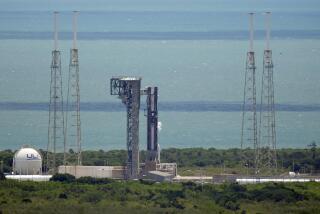Captain of Apollo 13 Finds Even Model Rockets Have Glitches
- Share via
UNIVERSAL CITY — “Five, four . . . “ Capt. James Lovell, commander of the ill-fated Apollo 13, sat a short distance from the black-tipped yellow rocket.
“Three, two . . . “
The event was a model rocket competition here on Thursday. The crowd joined in on the countdown’s final seconds.
“One!”
Nothing. The rocket’s thrusters failed to fire. The crowd remained quiet, except for a few nervous whispers. On the launch pad, the rocket remained a still life.
“Uh-oh,” said Lovell. “Houston, it looks like we’ve got a problem here.”
Lovell’s deadpan comment echoed his all-too-real broadcast to Mission Control 25 years ago, when he and two other men were in a faltering spacecraft 200,000 miles from home. But this time, with the stakes much lower, his line got a huge laugh.
Lovell and fellow astronaut Wally Schirra judged the competition among 30 fifth-graders from Oxnard Street Elementary School in North Hollywood.
The event marked the opening of the “Making of Apollo 13” attraction at Universal Studios Hollywood. The exhibit, featuring a cutaway of the Apollo 13 command module and replica space suits, sat next door to the An American Tail Theatre and the set of the Rocky and Bullwinkle Show.
“When I was a little kid, we didn’t have engines like this,” said Lovell, looking over a rocket that was to be launched. He said he was an avid model rocket builder as a child.
“I had to use my own propellant. I used gunpowder. It didn’t come back down.”
For the competition’s first entry, the problem was leaving the ground rather than returning, although the rocket finally lifted skyward on the third attempt.
“This was your Gemini 6 flight Wally,” quipped Lovell, referring to Schirra’s 1965 mission that was twice aborted on the launch pad. “I knew it.”
Schirra laughed. “Just think, this is all put together by the lowest bidder,” he said, repeating an old joke among veterans of the space program.
All five model rockets ultimately launched and landed safely. All the students received passes for a daylong, general science workshop at the Los Angeles Museum of Science and Industry.
Students on the team with the highest-flying model--Laura Blanco, Miguel Figueroa, Chris Orantes, Martha Sencion, David Villagrana and Cynthia Zuniga--were also awarded a weeklong visit to U.S. Space Camp, operated by NASA, in Alabama.
“This is definitely a lifetime memory,” said Lourdes Knapp, a sixth-grade teacher who accompanied the students. “How often do you get a chance to meet a real-life astronaut?”
“What we’re trying to do is give them some enthusiasm about education, whether they become a rocket engineer or a doctor,” said Lovell. “It [Apollo 13] is a reminder not only of where we have been, but also where we can go in the future.”
Lovell co-wrote “Lost Moon” about the troubled 1970 space flight. The book was the basis for the just-released film.
Schirra was one of the original Mercury 7 astronauts. He also commanded Apollo 7 and served on Gemini 6.
“After three [space] flights, it’s nice to be here,” Schirra, 72, told the crowd at Universal City. “At my age it’s nice to be anywhere.”
Renewed interest in the Apollo 13 mission allowed both men to dust off other tried-and-true quips.
One student asked the astronauts what their favorite sight was during their adventures in the space program.
“The parachute,” Schirra said.
“The water,” Lovell corrected.
The easy banter continued throughout the program, proving that, for these two former astronauts, there was really no problem here at all.
More to Read
Sign up for Essential California
The most important California stories and recommendations in your inbox every morning.
You may occasionally receive promotional content from the Los Angeles Times.













